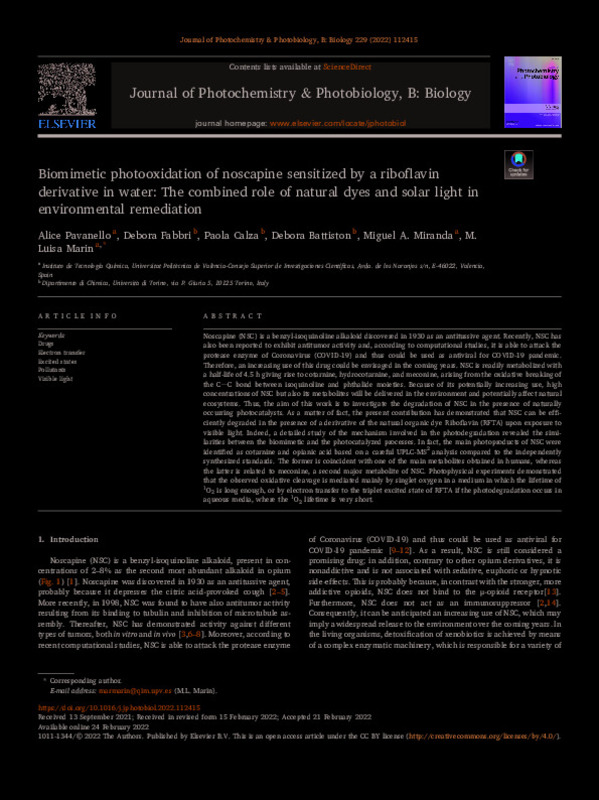JavaScript is disabled for your browser. Some features of this site may not work without it.
Buscar en RiuNet
Listar
Mi cuenta
Estadísticas
Ayuda RiuNet
Admin. UPV
Biomimetic photooxidation of noscapine sensitized by a riboflavin derivative in water: The combined role of natural dyes and solar light in environmental remediation
Mostrar el registro sencillo del ítem
Ficheros en el ítem
| dc.contributor.author | Pavanello, Alice
|
es_ES |
| dc.contributor.author | Fabbri, Debora
|
es_ES |
| dc.contributor.author | Calza, Paola
|
es_ES |
| dc.contributor.author | Battiston, Debora
|
es_ES |
| dc.contributor.author | Miranda Alonso, Miguel Ángel
|
es_ES |
| dc.contributor.author | Marín García, Mª Luisa
|
es_ES |
| dc.date.accessioned | 2023-10-04T18:01:53Z | |
| dc.date.available | 2023-10-04T18:01:53Z | |
| dc.date.issued | 2022-04 | es_ES |
| dc.identifier.issn | 1011-1344 | es_ES |
| dc.identifier.uri | http://hdl.handle.net/10251/197573 | |
| dc.description.abstract | [EN] Noscapine (NSC) is a benzyl-isoquinoline alkaloid discovered in 1930 as an antitussive agent. Recently, NSC has also been reported to exhibit antitumor activity and, according to computational studies, it is able to attack the protease enzyme of Coronavirus (COVID-19) and thus could be used as antiviral for COVID-19 pandemic. Therefore, an increasing use of this drug could be envisaged in the coming years. NSC is readily metabolized with a half-life of 4.5 h giving rise to cotarnine, hydrocotarnine, and meconine, arising from the oxidative breaking of the C-C bond between isoquinoline and phthalide moieties. Because of its potentially increasing use, high concentrations of NSC but also its metabolites will be delivered in the environment and potentially affect natural ecosystems. Thus, the aim of this work is to investigate the degradation of NSC in the presence of naturally occurring photocatalysts. As a matter of fact, the present contribution has demonstrated that NSC can be efficiently degraded in the presence of a derivative of the natural organic dye Riboflavin (RFTA) upon exposure to visible light. Indeed, a detailed study of the mechanism involved in the photodegradation revealed the similarities between the biomimetic and the photocatalyzed processes. In fact, the main photoproducts of NSC were identified as cotarnine and opianic acid based on a careful UPLC-MS2 analysis compared to the independently synthesized standards. The former is coincident with one of the main metabolites obtained in humans, whereas the latter is related to meconine, a second major metabolite of NSC. Photophysical experiments demonstrated that the observed oxidative cleavage is mediated mainly by singlet oxygen in a medium in which the lifetime of O-1(2) is long enough, or by electron transfer to the triplet excited state of RFTA if the photodegradation occurs in aqueous media, where the O-1(2) lifetime is very short. | es_ES |
| dc.description.sponsorship | This work has been partially funded by the European Union, under the Marie Sklodowska-Curie scheme (Grant No 765860, AQUAlity) . The Generalitat Valenciana (PROMETEO/2017/075) and the Spanish Government (Grant PID2019-110441RB-C33 financed by MCIN/AEI/10 .13039/501100011033) are also gratefully acknowledged. | es_ES |
| dc.language | Inglés | es_ES |
| dc.publisher | Elsevier | es_ES |
| dc.relation.ispartof | Journal of Photochemistry and Photobiology B Biology | es_ES |
| dc.rights | Reconocimiento (by) | es_ES |
| dc.subject | Drugs | es_ES |
| dc.subject | Electron transfer | es_ES |
| dc.subject | Excited states | es_ES |
| dc.subject | Pollutants | es_ES |
| dc.subject | Visible light | es_ES |
| dc.subject.classification | QUIMICA ORGANICA | es_ES |
| dc.title | Biomimetic photooxidation of noscapine sensitized by a riboflavin derivative in water: The combined role of natural dyes and solar light in environmental remediation | es_ES |
| dc.type | Artículo | es_ES |
| dc.identifier.doi | 10.1016/j.jphotobiol.2022.112415 | es_ES |
| dc.relation.projectID | info:eu-repo/grantAgreement/AEI/Plan Estatal de Investigación Científica y Técnica y de Innovación 2017-2020/PID2019-110441RB-C33/ES/SINTESIS, CARACTERIZACION Y EVALUACION DE NUEVOS FOTOCATALIZADORES: ANALISIS DE PATOGENOS MICROBIANOS Y MICROCONTAMINANTES ORGANICOS COMO INDICADORES DE CALIDAD/ | es_ES |
| dc.relation.projectID | info:eu-repo/grantAgreement/GVA//PROMETEO%2F2017%2F075//Reacciones fotoquímicas de biomoléculas/ | es_ES |
| dc.relation.projectID | info:eu-repo/grantAgreement/EC/H2020/765860/EU | es_ES |
| dc.rights.accessRights | Abierto | es_ES |
| dc.contributor.affiliation | Universitat Politècnica de València. Escuela Técnica Superior de Ingenieros Industriales - Escola Tècnica Superior d'Enginyers Industrials | es_ES |
| dc.description.bibliographicCitation | Pavanello, A.; Fabbri, D.; Calza, P.; Battiston, D.; Miranda Alonso, MÁ.; Marín García, ML. (2022). Biomimetic photooxidation of noscapine sensitized by a riboflavin derivative in water: The combined role of natural dyes and solar light in environmental remediation. Journal of Photochemistry and Photobiology B Biology. 229:1-8. https://doi.org/10.1016/j.jphotobiol.2022.112415 | es_ES |
| dc.description.accrualMethod | S | es_ES |
| dc.relation.publisherversion | https://doi.org/10.1016/j.jphotobiol.2022.112415 | es_ES |
| dc.description.upvformatpinicio | 1 | es_ES |
| dc.description.upvformatpfin | 8 | es_ES |
| dc.type.version | info:eu-repo/semantics/publishedVersion | es_ES |
| dc.description.volume | 229 | es_ES |
| dc.identifier.pmid | 35231758 | es_ES |
| dc.relation.pasarela | S\466997 | es_ES |
| dc.contributor.funder | European Commission | es_ES |
| dc.contributor.funder | Generalitat Valenciana | es_ES |
| dc.contributor.funder | Agencia Estatal de Investigación | es_ES |
| dc.contributor.funder | COMISION DE LAS COMUNIDADES EUROPEA | es_ES |
| dc.contributor.funder | Universitat Politècnica de València | es_ES |








